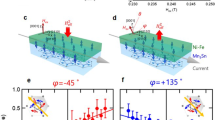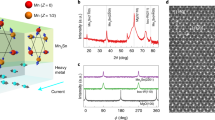Abstract
The spin Hall effect (SHE)1,2,3,4,5 achieves coupling between charge currents and collective spin dynamics in magnetically ordered systems and is a key element of modern spintronics6,7,8,9. However, previous research has focused mainly on non-magnetic materials, so the magnetic contribution to the SHE is not well understood. Here we show that antiferromagnets have richer spin Hall properties than do non-magnetic materials. We find that in the non-collinear antiferromagnet10 Mn3Sn, the SHE has an anomalous sign change when its triangularly ordered moments switch orientation. We observe contributions to the SHE (which we call the magnetic SHE) and the inverse SHE (the magnetic inverse SHE) that are absent in non-magnetic materials and that can be dominant in some magnetic materials, including antiferromagnets. We attribute the dominance of this magnetic mechanism in Mn3Sn to the momentum-dependent spin splitting that is produced by non-collinear magnetic order. This discovery expands the horizons of antiferromagnet spintronics and spin–charge coupling mechanisms.
This is a preview of subscription content, access via your institution
Access options
Access Nature and 54 other Nature Portfolio journals
Get Nature+, our best-value online-access subscription
$29.99 / 30 days
cancel any time
Subscribe to this journal
Receive 51 print issues and online access
$199.00 per year
only $3.90 per issue
Buy this article
- Purchase on Springer Link
- Instant access to full article PDF
Prices may be subject to local taxes which are calculated during checkout




Similar content being viewed by others
Data availability
The data that support the findings of this study are available from the corresponding author upon reasonable request.
Change history
22 January 2019
In this Letter, the formatting of some of the crystallographic axes was incorrect. This has been corrected online.
References
Dyakonov, M. I. & Perel, V. I. Possibility of orientating electron spins with current. Sov. J. Exp. Theor. Phys. Lett. 13, 467–469 (1971).
Hirsch, J. E. Spin Hall effect. Phys. Rev. Lett. 83, 1834–1837 (1999).
Kato, Y., Myers, R. C., Gossard, A. C. & Awschalom, D. D. Observation of the spin Hall effect in semiconductors. Science 306, 1910–1913 (2004).
Wunderlich, J., Kaestner, B., Sinova, J. & Jungwirth, T. Experimental observation of the spin-Hall effect in a two-dimensional spin–orbit coupled semiconductor system. Phys. Rev. Lett. 94, 047204 (2005).
Sinova, J. et al. Spin Hall effects. Rev. Mod. Phys. 87, 1213–1260 (2015).
Saitoh, E. et al. Conversion of spin current into charge current at room temperature: inverse spin-Hall effect. Appl. Phys. Lett. 88, 182509 (2006).
Kimura, T., Otani, Y., Sato, T., Takahashi, S. & Maekawa, S. Room-temperature reversible spin Hall effect. Phys. Rev. Lett. 98, 156601 (2007).
Liu, L. et al. Spin-torque switching with the giant spin Hall effect of tantalum. Science 336, 555–558 (2012).
Jungwirth, T. et al. Spin Hall effect devices. Nat. Mater. 11, 382–390 (2012).
Nakatsuji, S. et al. Large anomalous Hall effect in a non-collinear antiferromagnet at room temperature. Nature 527, 212–215 (2015).
Freimuth, F. et al. Spin-orbit torques in Co/Pt(111) and Mn/W(001) magnetic bilayers from first principles. Phys. Rev. B 90, 174423 (2014).
Hals, K. M. D. & Brataas, A. Spin-motive forces and current-induced torques in ferromagnets. Phys. Rev. B 91, 214401 (2015).
Freimuth, F., Blügel, S. & Mokrousov, Y. Direct and inverse spin-orbit torques. Phys. Rev. B 92, 064415 (2015).
Chen, H., Niu, Q. & MacDonald, A. H. Anomalous Hall effect arising from noncollinear antiferromagnetism. Phys. Rev. Lett. 112, 017205 (2014).
Suzuki, M.-T., Koretsune, T., Ochi, M. & Arita, R. Cluster multipole theory for anomalous Hall effect in antiferromagnets. Phys. Rev. B 95, 094406 (2017).
Chien, C. L. & Westgate, C. R. The Hall Effect and its Applications (Plenum, 1980).
Nagaosa, N., Sinova, J., Onoda, S., MacDonald, A. H. & Ong, N. P. Anomalous Hall effect. Rev. Mod. Phys. 82, 1539–1592 (2010).
Tian, Y., Ye, L. & Jin, X. Proper scaling of the anomalous Hall effect. Phys. Rev. Lett. 103, 087206 (2009).
Morota, M. et al. Indication of intrinsic spin Hall effect in 4d and 5d transition metals. Phys. Rev. B 83, 174405 (2011).
Tserkovnyak, Y., Brataas, A. & Bauer, G. E. W. Enhanced Gilbert damping in thin ferromagnetic films. Phys. Rev. Lett. 88, 117601 (2002).
Harder, M., Cao, Z. X., Gui, Y. S., Fan, X. L. & Hu, C.-M. Analysis of the line shape of electrically detected ferromagnetic resonance. Phys. Rev. B 84, 054423 (2011).
Vasko, F. T. & Raichev, O. E. Quantum Kinetic Theory and Applications (Springer, New York, 2005).
Culcer, D., Sekine, A. & MacDonald, A. H. Inter-band coherence response to electric fields in crystals. Phys. Rev. B 96, 035106 (2017).
Aronov, A. G. & Lyanda-Geller, Y. B. Nuclear electric resonance and orientation of carrier spins by an electric field. JETP Lett. 50, 431–434 (1989).
Edelstein, V. M. Spin polarization of conduction electrons induced by electric current in two-dimensional asymmetric electron systems. Solid State Commun. 73, 233–235 (1990).
Garate, I. & MacDonald, A. H. Influence of a transport current on magnetic anisotropy in gyrotropic ferromagnets. Phys. Rev. B 80, 134403 (2009).
Železný, J., Zhang, Y., Felser, C. & Yan, B. Spin-polarized current in noncollinear antiferromagnets. Phys. Rev. Lett. 119, 187204 (2017).
Ikhlas, M. et al. Large anomalous Nernst effect at room temperature in a chiral antiferromagnet. Nat. Phys. 13, 1085–1090 (2017).
Fukuma, Y. et al. Giant enhancement of spin accumulation and long-distance spin precession in metallic lateral spin valves. Nat. Mater. 10, 527–531 (2011).
Narita, H. et al. Anomalous Nernst effect in a microfabricated thermoelectric element made of chiral antiferromagnet Mn3Sn. Appl. Phys. Lett. 111, 202404 (2017).
Shiomi, Y. et al. Spin–electricity conversion induced by spin injection into topological insulators. Phys. Rev. Lett. 113, 196601 (2014).
Birss, R. R. Symmetry and Magnetism (North-Holland, Amsterdam, 1966).
Taniguchi, T., Grollier, J. & Stiles, M. D. Spin-transfer torques generated by the anomalous Hall effect and anisotropic magnetoresistance. Phys. Rev. Appl. 3, 044001 (2015).
Acknowledgements
This work is partially supported by CREST (grant numbers JPMJCR15Q5 and JPMJCR18T3), the Japan Science and Technology Agency, Grants-in-Aid for Scientific Research (16H02209, 25707030), Grants-in-Aids for Scientific Research on Innovative Areas (15H05882, 15H05883, 26103001, 26103002) and the Program for Advancing Strategic International Networks to Accelerate the Circulation of Talented Researchers (R2604) from the Japanese Society for the Promotion of Science. H.C. and A.H.M. were supported by SHINES, an Energy Frontier Research Center funded by the US Department of Energy, Office of Science, Basic Energy Sciences, under award SC0012670.
Author information
Authors and Affiliations
Contributions
Y. Otani and S.N. planned the experimental project, and M.K., Y. Omori, M.I., T.T., S.S., P.K.M. and K.K. fabricated the devices. M.K., S.S. and K.K. performed the experiments and collected data. H.C. and A.H.M. performed the theoretical analyses. M.K., H.C., K.K., S.N., A.H.M. and Y. Otani wrote the manuscript, and M.K., K.K. and H.C. prepared the Methods section and the figures. All authors discussed the results and commented on the manuscript.
Corresponding author
Ethics declarations
Competing interests
The authors declare no competing interests.
Additional information
Publisher’s note: Springer Nature remains neutral with regard to jurisdictional claims in published maps and institutional affiliations.
Extended data figures and tables
Extended Data Fig. 1 Switching field of microfabricated Mn3Sn signle crystals.
a, External-magnetic-field dependence of AHE resistance in the spin-accumulation device. The resistance jump around ±2,000 Oe corresponds to the magnetization reversal of the microfabricated Mn3Sn crystal. The observed AHE resistance is much smaller than that expected in the bulk samples because the AHE signal in this device arises from the slight tilting of the sample’s basal plane from the crystallographic kagome plane. b, External-magnetic-field dependence of d.c. voltage under the application of an a.c. current in the spin-pumping device. The sharp voltage jumps around ±1,200 Oe correspond to the magnetization reversal field Hc of Mn3Sn.
Extended Data Fig. 2 Comparison of FMR-induced d.c. voltage signals in NiFe/Mn3Sn bilayer and NiFe single layers.
External-magnetic-field dependence of d.c. voltage signal under FMR excitation. The green and blue lines are symmetric and asymmetric voltage contributions, respectively. The voltage signals are normalized by the asymmetric voltage amplitude. The symmetric voltage contribution in the NiFe/Mn3Sn bilayer (left) is considerably enhanced compared with that of the Ni80Fe20 single layer (right); Py, permalloy.
Extended Data Fig. 3 Frequency and angular dependence of spin-pumping experiment.
a, Frequency dependence of the ratio between symmetric (Vsym) and asymmetric (Vanti) voltage contributions for f = 10–13 GHz. The value of Vsym/Vanti is independent of the microwave frequency. b, Magnetic-field-angle dependence of symmetric voltage signals at several microwave frequencies.
Extended Data Fig. 4 Toy model for MSHE and MISHE calculations.
Left, bilayer kagome toy model mimicking the (0001) surface of Mn3Sn. Right, band structure of the toy model with Λ = 0.1t, J = 1.5t and λR = 0.2t. The horizontal axis shows the wavevector k nomalized by the lattice constant a.
Extended Data Fig. 5 Angular dependence of interband contribution of current-induced spin density.
Interband contribution to the current (along x) induced spin density for the toy model in equation (19) with Λ = 0.1t, J = 1.5t and λR = 0.2t. Only the first half of the rotation (anticlockwise, from 0 to π) is shown. The second half is related to the first through time reversal.
Extended Data Fig. 6 Calculated intraband contribution of time-dependent current induced by magnetization precession.
Intraband contribution to the time-dependent current induced by precessing magnetization for the model described by equations (12) and (23) with Λ = 0.2t, J = 0, λR = 0.2t, θ = 0.1, |Δ| = 0.5t, EF = 2t and kBT = 0.1t (EF, Fermi energy; kB, Boltzmann constant).
Extended Data Fig. 7 Calculated intraband contribution of time-dependent current induced by magnetization precession without spin–orbit interaction.
Intraband contribution to the time-dependent current induced by precessing magnetization for the model described by equations (12) and (23) without spin–orbit coupling. The other parameters are Λ = 0.2t, J = 0.6t, θ = 0.1, |Δ| = 0.5t, EF = 2t and kBT = 0.1t.
Extended Data Fig. 8 Model calculation of angular dependence for MISHE.
MISHE versus in-plane magnetic-field direction, calculated using the same geometry as the experiment. The parameters are Λ = 0.1t, J = 1.5t, λR = 0.2t, EF = 0 and kBT = 0.1t (for faster convergence of numerical integration over the Brillouin zone).
Rights and permissions
About this article
Cite this article
Kimata, M., Chen, H., Kondou, K. et al. Magnetic and magnetic inverse spin Hall effects in a non-collinear antiferromagnet. Nature 565, 627–630 (2019). https://doi.org/10.1038/s41586-018-0853-0
Received:
Accepted:
Published:
Issue Date:
DOI: https://doi.org/10.1038/s41586-018-0853-0
This article is cited by
-
Spin-resolved topology and partial axion angles in three-dimensional insulators
Nature Communications (2024)
-
Effective electrical manipulation of a topological antiferromagnet by orbital torques
Nature Communications (2024)
-
Interfacial magnetic spin Hall effect in van der Waals Fe3GeTe2/MoTe2 heterostructure
Nature Communications (2024)
-
Observation of plaid-like spin splitting in a noncoplanar antiferromagnet
Nature (2024)
-
Large anomalous Hall effect and unusual domain switching in an orthorhombic antiferromagnetic material NbMnP
npj Quantum Materials (2023)
Comments
By submitting a comment you agree to abide by our Terms and Community Guidelines. If you find something abusive or that does not comply with our terms or guidelines please flag it as inappropriate.



